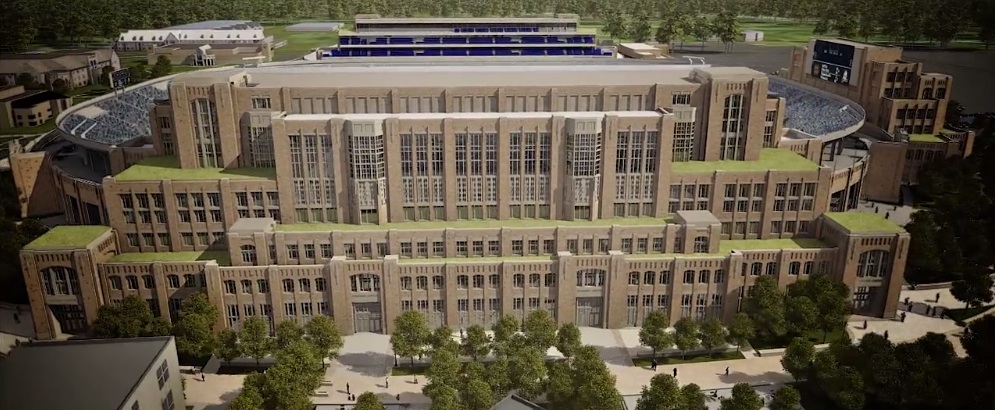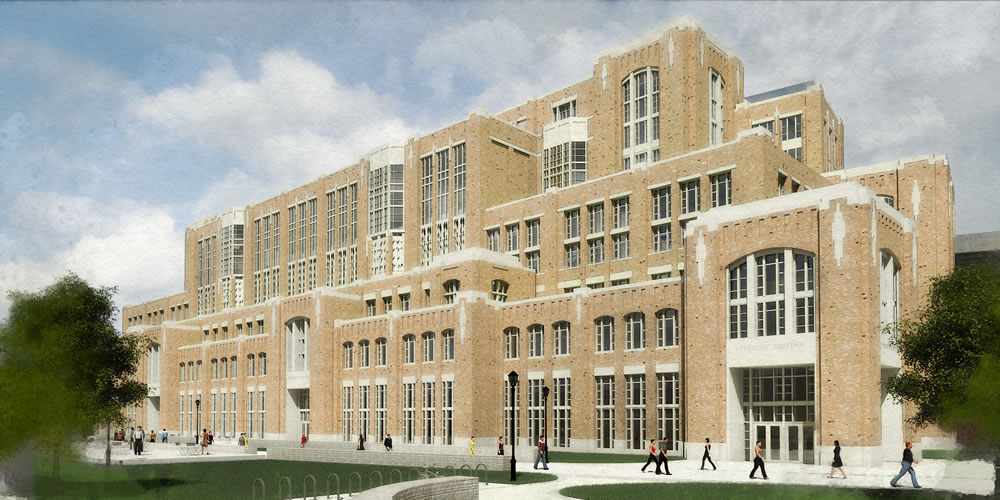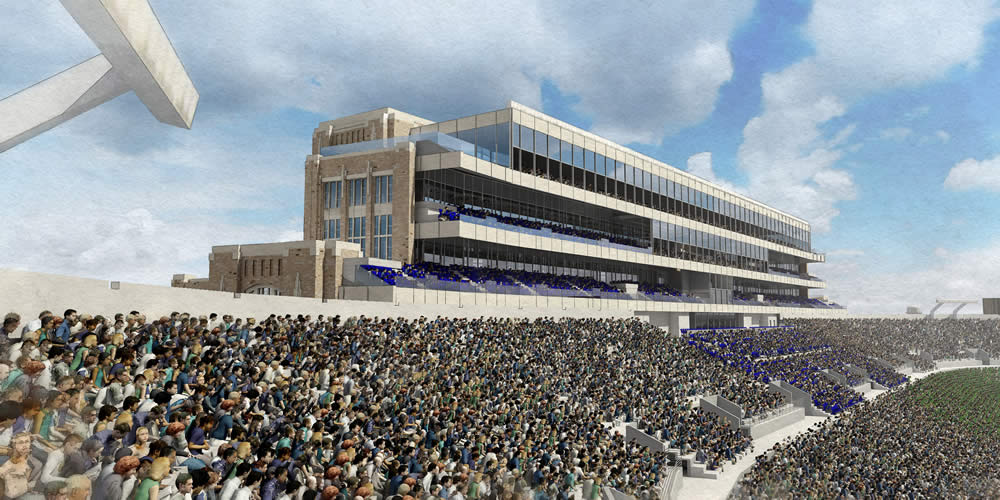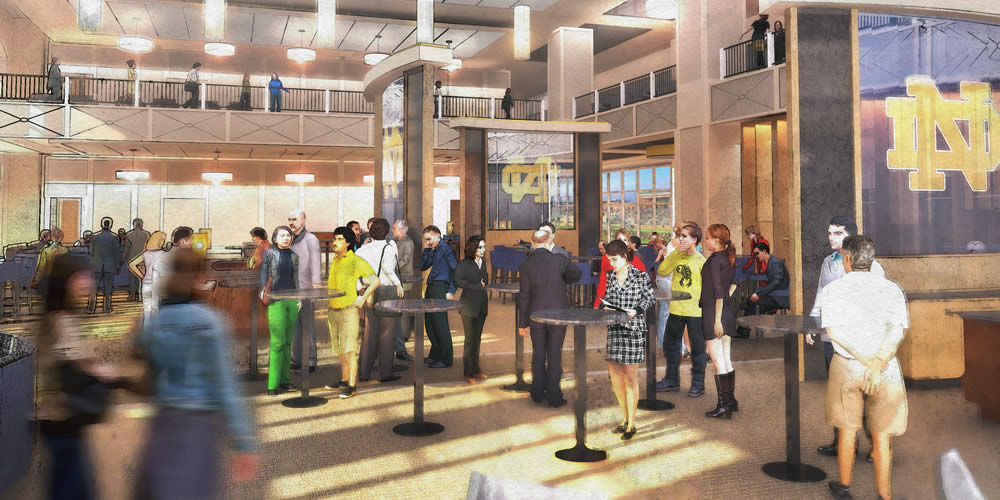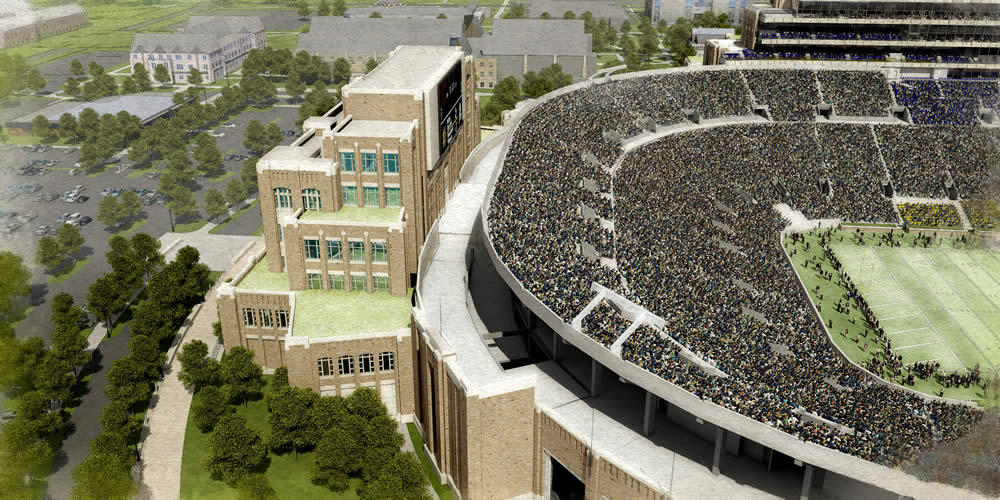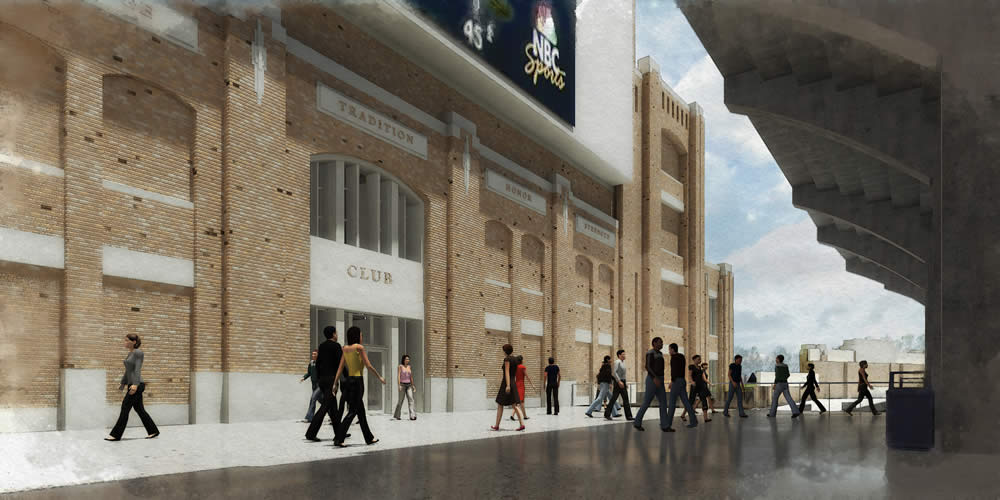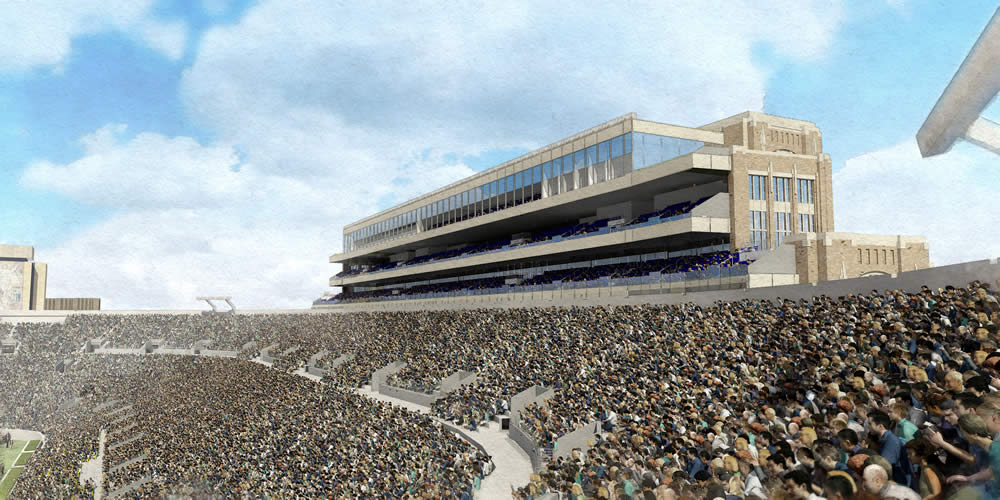The University of Notre Dame announced this morning the largest building project in its 172-year history, integrating the academy, student life, and athletics with the construction of more than 750,000 sf in three new buildings attached to the west, east, and south sides of the school's iconic football stadium, at a projected cost of $400 million.
The plan, called the Campus Crossroads Project, features new structures attached to and serving the stadium: a west building for student life services, including space for student organizations, a recreation center and career center; an east building for the anthropology and psychology departments and a digital media center; and a south building for the Department of Music and the Sacred Music at Notre Dame program. The east and west buildings also will include some 3,000 to 4,000 premium seats for the football stadium with supporting club amenities.
The lead architectural firm for the Crossroads Project is The S/L/A/M Collaborative. RATIO Architects is the co-designer. Other consultants include Workshop Architects for the student center and 360 Architecture for the recreation, fitness, and hospitality areas. The contractor is Barton Malow Co.
Central components to the plan include the addition of meeting, research, and teaching venues, as well as facilities that do not currently exist on campus, such as a 500-person ballroom. The various new spaces also will be designed to accommodate multiple functions for multiple departments, such as the stadium club spaces, which also will be used for student services, academic event space, classrooms, conferences, career fairs, and other campus and community activities.
The exterior design of the Campus Crossroads Project is inspired by Knute Rockne’s original Notre Dame Stadium—which still stands today as the core of the facility—and is wed with materials, massing, and details taken from many of the Collegiate Gothic buildings on the campus.
The area between the stadium and the DeBartolo Hall classroom building will become a pedestrian plaza with walkways, trees, planters, and seating areas. The entire project will include sustainability practices consistent with other University projects.
The project also will enhance the football fan experience on game days. A variety of premium seating options—both indoor and outdoor and mostly club seats—will be available on three upper levels on the east and west sides. A hospitality area also is planned for the new building on the south end of the stadium.
Football fans, especially younger ones, have expressed a clear desire to have better access to data and video when attending Notre Dame games. Some of that will be addressed through enhanced broadband connectivity and some by the introduction of video, though the shape that will take has not yet been finalized. However, to the extent the University provides video, whether in the concourse or in the stadium itself—similar to the philosophy in Purcell Pavilion and the Compton Family Ice Arena—there will be no commercial signage or advertising.
Notre Dame Stadium opened in 1930 and was expanded to its current configuration in 1997. One of the nation’s most iconic athletics venues, it is used for home football games, the University Commencement Ceremony and several other events.
Features of the three new buildings include:
West building
Space designed to enhance student development and formation will dominate the nine-story west building. Planning has ensured that the new facility will complement the student organization space and administrative offices located in the historic LaFortune Student Center.
Levels 1 and 2: Flexible, state-of-the-art meeting rooms, graduate and undergraduate student lounges, a dining area, student organization space and administrative offices.
Levels 3 and 4: Recreational sports and fitness facilities (the Rolfs Sports Recreation Center will become the practice home for the men’s and women’s varsity basketball teams).
Level 5: A career services center, centralized and expanded with more than 40 interview rooms, multiple training rooms and conference areas, an employer lounge and advising offices. The existing working press space on this level will be integrated into a premium seating area for the stadium.
Level 6: Mechanical support.
Level 7: A 500-seat student ballroom, club seating for football and booths for NBCSports telecasts of home football games. Student-oriented programming will have priority booking for non-game weekends.
Level 8: Premium stadium seats and terraces that will look onto the campus and the playing field.
Level 9: Club seating, boxes for home and visiting coaches, security booths and boxes for administrative and athletic department leaders.
Basement: Food service space for the three new buildings and the stadium.
South building
The relocation of the Department of Music and Sacred Music Program will provide much needed new and state-of-the-art space for these growing programs. It also will put music into close proximity to other performing arts departments and programs.
Level 1: Recital and rehearsal halls and the Leahy gate grand entrance to the stadium.
Level 2: A large music library, to be relocated from the Hesburgh Library, classrooms and rehearsal and tutoring rooms.
Level 3: A 350-person club/lounge.
Level 4: Department of Music offices, practice rooms and storage.
Level 5: The Sacred Music Program, offices, organ practice rooms and storage.
Level 6: Mechanical, with a scoreboard on the exterior.
East building
Offices and laboratories for the Departments of Anthropology andPsychology, which are housed in a variety of buildings on campus, now will be in one place and located closer to other social sciences departments, the College of Scienceand international institutes.
Level 1: A digital media center with a 2,000-square-foot studio and production, teaching, learning, research and scholarship facilities for use by faculty, students, University Communications, athletics and information technology will position Notre Dame as a national leader in what is a rapidly expanding and increasingly important component of higher education. A control room will support faith-based programming, such as Masses at the Basilica of the Sacred Heart, as well as athletics events, performing arts presentations and academic lectures and speeches.
Level 2: Anthropology offices, administrative space, conference and tutoring areas and multifunction research and teaching labs.
Levels 3, 4 and 5: Psychology offices, classrooms, labs, computer rooms and a student lounge.
Level 6: Mechanical support.
Level 7: Outdoor club seating for football, outdoor terraces and a large space that will double as a club area and flexible classroom.
Level 8: Outdoor club seating for football.
Level 9: Working press box, radio booths and a club area with indoor and outdoor premium seating for football.
For more on the Campus Crossroads Project, visit: http://crossroads.nd.edu.
Related Stories
Adaptive Reuse | Mar 21, 2024
Massachusetts launches program to spur office-to-residential conversions statewide
Massachusetts Gov. Maura Healey recently launched a program to help cities across the state identify underused office buildings that are best suited for residential conversions.
Legislation | Mar 21, 2024
Bill would mandate solar panels on public buildings in New York City
A recently introduced bill in the New York City Council would mandate solar panel installations on the roofs of all city-owned buildings. The legislation would require 100 MW of solar photovoltaic systems be installed on public buildings by the end of 2025.
Office Buildings | Mar 21, 2024
BOMA updates floor measurement standard for office buildings
The Building Owners and Managers Association (BOMA) International has released its latest floor measurement standard for office buildings, BOMA 2024 for Office Buildings – ANSI/BOMA Z65.1-2024.
Healthcare Facilities | Mar 18, 2024
A modular construction solution to the mental healthcare crisis
Maria Ionescu, Senior Medical Planner, Stantec, shares a tested solution for the overburdened emergency department: Modular hub-and-spoke design.
Codes and Standards | Mar 18, 2024
New urban stormwater policies treat rainwater as a resource
U.S. cities are revamping how they handle stormwater to reduce flooding and capture rainfall and recharge aquifers. New policies reflect a change in mindset from treating stormwater as a nuisance to be quickly diverted away to capturing it as a resource.
Plumbing | Mar 18, 2024
EPA to revise criteria for WaterSense faucets and faucet accessories
The U.S. Environmental Protection Agency (EPA) plans to revise its criteria for faucets and faucet accessories to earn the WaterSense label. The specification launched in 2007; since then, most faucets now sold in the U.S. meet or exceed the current WaterSense maximum flow rate of 1.5 gallons per minute (gpm).
MFPRO+ New Projects | Mar 18, 2024
Luxury apartments in New York restore and renovate a century-old residential building
COOKFOX Architects has completed a luxury apartment building at 378 West End Avenue in New York City. The project restored and renovated the original residence built in 1915, while extending a new structure east on West 78th Street.
Multifamily Housing | Mar 18, 2024
YWCA building in Boston’s Back Bay converted into 210 affordable rental apartments
Renovation of YWCA at 140 Clarendon Street will serve 111 previously unhoused families and individuals.
Healthcare Facilities | Mar 17, 2024
5 criteria to optimize medical office design
Healthcare designers need to consider privacy, separate areas for practitioners, natural light, outdoor spaces, and thoughtful selection of materials for medical office buildings.
Construction Costs | Mar 15, 2024
Retail center construction costs for 2024
Data from Gordian shows the most recent costs per square foot for restaurants, social clubs, one-story department stores, retail stores and movie theaters in select cities.



